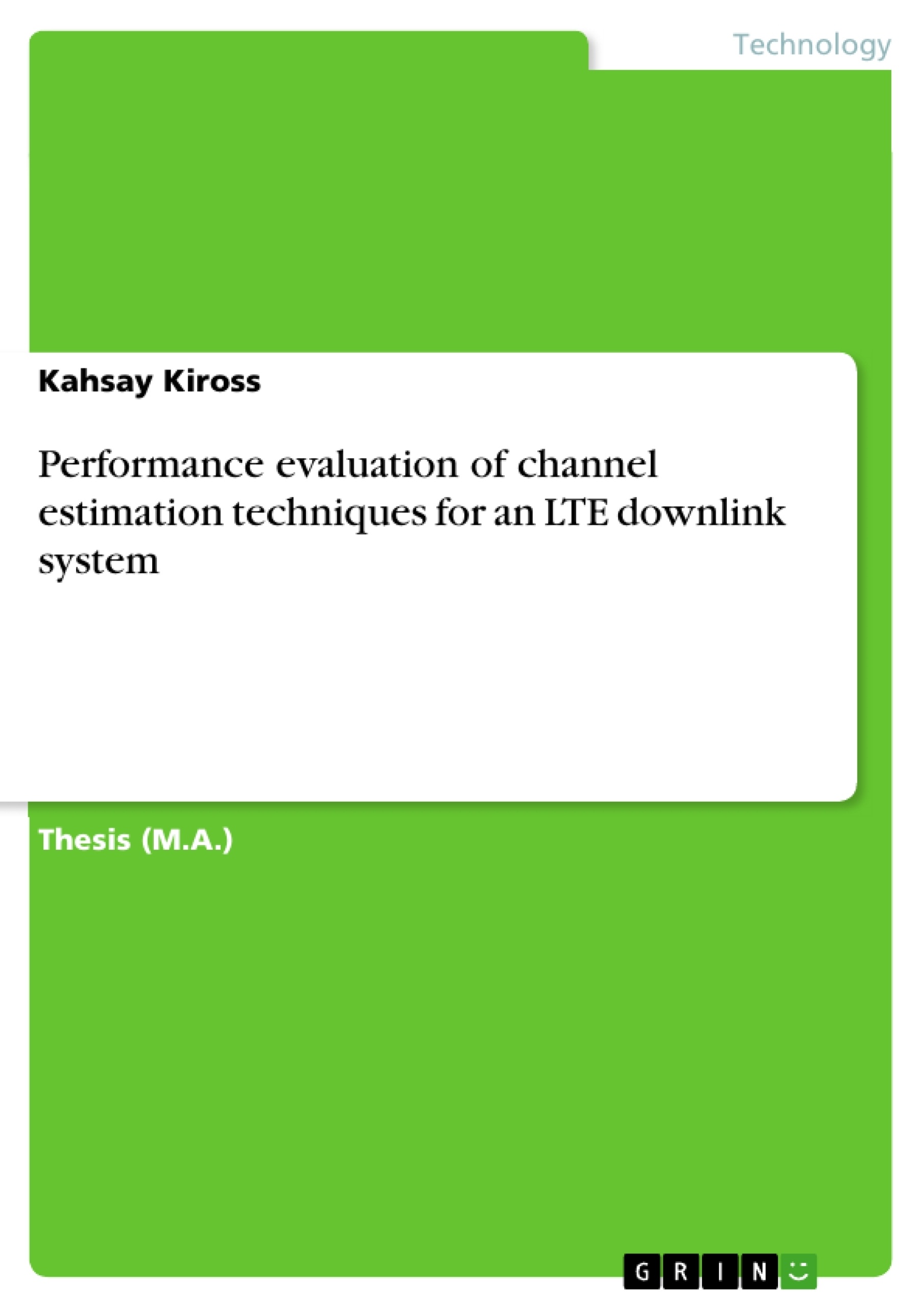In this thesis channel estimation techniques for LTE downlink named Least Square, Minimum Mean Square error and Maximum Likelihood estimation techniques are studied for the pilot symbol based channel estimation. In addition to this the performances of these three channel estimation techniques were also studied by introducing averaging, interpolation and hybrid methods.
This work also investigates the complexity of the channel estimation techniques in terms of the number of complex multiplications and by varying the FFT size and number of CP. furthermore, the effect of varying the number of antennas at the transmitter and receiver ends, where 2 x 2 and 4 x 4 antenna arrangements are considered as a case studies. The performance of these channel estimation techniques is also studied for EVA standard channel model in LTE. The considered channel model is EVA standard channel model with Doppler shift of 300HZ.
Simulation results in this thesis show that the ML channel estimation technique has the best performance. In terms of number of complex multiplications it is proved the ML has lower complexity. From the interpolating techniques it is shown the performance of the algorithm integrated with hybrid technique has the best performance. In addition to this it is shown that as the number of transmit and receive antennas increase from 2 x 2 to 4 x 4 the performance of the estimator increases.
Inhaltsverzeichnis (Table of Contents)
- CHAPTER ONE INTRODUCTION
- 1.1 Introduction
- 1.2 Literature Review
- 1.3 Statement of the problem
- 1.4 Thesis contribution
- 1.5 Objectives
- 1.6 Methodology
- 1.7 Thesis Outline
- CHAPTER TWO OVERVIEW OF LTE PHYSICAL LAYER
- 2.1. Air Interface of LTE
- 2.2. LTE Duplexing Methods
- 2.3. Allocation of Bandwidth and Time Framing
- 2.4. Time frequency representation
- 2.5. OFDM Multicarrier Transmission
- 2.6. The Cyclic Prefix
- 2.7. Subcarrier Spacing
- 2.8. Resource Block Size
- 2.9. Resource Grid Contents
- 2.10. OFDM Typical Transmitter Operation
- 2.11. OFDM Typical Receiver Operation
- 2.12 The general block diagram of the LTE downlink system
- 2.13. Types of Pilot Arrangements
- 2.13.1. Block Type Pilot Arrangement
- 2.13.2 Comb Type Pilot Arrangement
- 2.14. Wireless and mobile communication channel
- 2.15. Small scale fading
- 2.16. Propagation aspects and parameters
- 2.16.1 Delay spread
- 2.16.2. Maximum excess delay
- 2.16.3. Average delay
- 2.16.4. Root mean square delay
- 2.16.5. Coherence bandwidth
- 2.16.6. Doppler spread
- 2.16.7. Coherence time
- 2.17. Deep fade and diversity
- 2.17.1. The receive diversity
- 2.17.2. The transmit diversity
- 2.18. Multiple input multiple outputs (MIMO)
- 2.19. Diversity schemes
- CHAPTER THREE CHANNEL ESTIMATION TECHNIQUES
- 3.1. Introduction
- 3.2. The LS channel Estimator
- 3.3. MMSE Channel Estimator
- 3.4. MLE Channel Estimator
- 3.5. The Linear Interpolation
- 3.6. Averaging Channel Estimator
- 3.7. The Hybrid Channel Estimation
- 3.8. Algorithm complexity
- SYSTEM MODELING AND RESULT DISCUSSION
- 4.1 Introduction
- 4.2 System Model
- 4.2.1 Parameter Selection
- 4.2.2 CRC Generation and Channel Coding
- 4.2.3 Scrambling
- 4.2.4 Modulation
- 4.2.5 Layer mapping
Zielsetzung und Themenschwerpunkte (Objectives and Key Themes)
This thesis investigates channel estimation techniques for the Long-Term Evolution (LTE) downlink system, with a focus on pilot symbol-based methods. It examines the performance of various channel estimation techniques, including Least Square (LS), Minimum Mean Square Error (MMSE), and Maximum Likelihood Estimation (MLE). The work also analyzes the complexity of these techniques and explores the effects of different system parameters, such as the number of antennas, FFT size, and Cyclic Prefix (CP).
- Performance evaluation of different channel estimation techniques for LTE downlink
- Complexity analysis of channel estimation techniques
- Impact of system parameters on channel estimation performance
- Implementation and simulation of channel estimation algorithms
- Comparative study of different channel estimation methods
Zusammenfassung der Kapitel (Chapter Summaries)
- Chapter One: Introduction - This chapter provides a background on the topic, outlines the problem statement, details the thesis contribution, and defines objectives and methodology.
- Chapter Two: Overview of LTE Physical Layer - This chapter presents a comprehensive overview of the LTE physical layer, including its air interface, duplexing methods, bandwidth allocation, time framing, and key technologies such as OFDM and MIMO.
- Chapter Three: Channel Estimation Techniques - This chapter delves into different channel estimation techniques employed for LTE downlink. It covers LS, MMSE, and MLE estimators, along with techniques like linear interpolation, averaging, and hybrid estimation. It also analyzes the complexity of these techniques.
- System Modeling and Result Discussion - This chapter presents the system model used for simulation and analysis of the channel estimation techniques. It describes the parameter selection, channel coding, scrambling, modulation, and layer mapping processes. The chapter also discusses the results and findings obtained from the simulation.
Schlüsselwörter (Keywords)
Channel Estimation, LTE Downlink, Least Squares (LS), Minimum Mean Square Error (MMSE), Maximum Likelihood Estimation (MLE), Pilot Symbols, OFDM, MIMO, Complexity Analysis, System Modeling, Simulation, Performance Evaluation.
- Quote paper
- Kahsay Kiross (Author), 2016, Performance evaluation of channel estimation techniques for an LTE downlink system, Munich, GRIN Verlag, https://www.grin.com/document/346942



